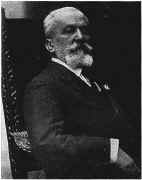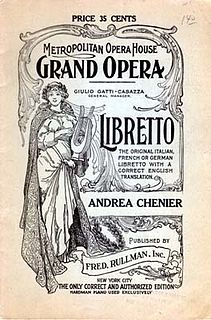Opera buffa is a genre of opera. It was first used as an informal description of Italian comic operas variously classified by their authors as commedia in musica, commedia per musica, dramma bernesco, dramma comico, divertimento giocoso.

A melodrama is a dramatic work in which the plot, which is typically sensational and designed to appeal strongly to the emotions, takes precedence over detailed characterization. Characters are often simply drawn, and may appear stereotyped. Melodramas are typically set in the private sphere of the home, and focus on morality and family issues, love, and marriage, often with challenges from an outside source, such as a "temptress”, an aristocratic villain.

Neoclassicism in music was a twentieth-century trend, particularly current in the interwar period, in which composers sought to return to aesthetic precepts associated with the broadly defined concept of "classicism", namely order, balance, clarity, economy, and emotional restraint. As such, neoclassicism was a reaction against the unrestrained emotionalism and perceived formlessness of late Romanticism, as well as a "call to order" after the experimental ferment of the first two decades of the twentieth century. The neoclassical impulse found its expression in such features as the use of pared-down performing forces, an emphasis on rhythm and on contrapuntal texture, an updated or expanded tonal harmony, and a concentration on absolute music as opposed to Romantic program music.
A number opera is an opera consisting of individual pieces of music ('numbers') which can be easily extracted from the larger work. They may be numbered consecutively in the score, and may be interspersed with recitative or spoken dialogue. Opera numbers may be arias, but also ensemble pieces, such as duets, trios, quartets, quintets, sextets or choruses. They may also be ballets and instrumental pieces, such as marches, sinfonias, or intermezzi. The number opera format was standard until the mid-19th century and most opera genres, including opera seria, opera buffa, opéra comique, ballad opera, Singspiel, and grand opera, were constructed in this fashion.

In music, a trio is a method of instrumentation or vocalization by three different sounds or voices to make a melodious music or song.

Torquato Tasso is a melodramma semiserio, or 'semi-serious' opera, in three acts by Gaetano Donizetti and based on the life of the great poet Torquato Tasso. The Italian libretto was written by Jacopo Ferretti, who used a number of sources for his text, including works by Giovanni Rosini, Goethe, Goldoni, and Lord Byron as well as Tasso's actual poetry. It premiered on 9 September 1833 at the Teatro Valle, Rome.

Imelda de' Lambertazzi is a melodramma tragico or tragic opera in two acts by Gaetano Donizetti from a libretto by Andrea Leone Tottola, based on the tragedy Imelda by Gabriele Sperduti. It received its first performance on 5 September 1830 at the Teatro San Carlo, Naples.

Gianni di Parigi is an 1839 melodramma comico in two acts with music by Gaetano Donizetti to a libretto by Felice Romani, which had previously been set by Francesco Morlacchi in 1818 and by Giovanni Antonio Speranza in 1836.

Rescue opera was a genre of opera in the late 18th and early 19th centuries in France and Germany. Generally, rescue operas deal with the rescue of a main character from danger and end with a happy dramatic resolution in which lofty humanistic ideals triumph over base motives. Operas with this kind of subject matter became popular in France around the time of the French Revolution; a number of such operas dealt with the rescue of a political prisoner. Stylistically and thematically, rescue opera was an outgrowth of the French bourgeois opéra comique; musically, it began a new tradition that would influence German Romantic opera and French grand opera. The most famous rescue opera is Ludwig van Beethoven's Fidelio.
Fioritura is the florid embellishment of melodic lines, either notated by a composer or improvised during a performance. It usually involves lengthy, complex embellishments, as opposed to standardized local ornamental figures such as trills, mordents, or appoggiaturas, and its use is documented as early as the thirteenth century. The alternative term "coloratura" is less accurate. It is closely related to the sixteenth-century practice of diminution or division.
Joseph Wilfred Kerman was an American critic and musicologist. One of the leading musicologists of his generation, his 1985 book Contemplating Music: Challenges to Musicology was described by Philip Brett in The Grove Dictionary of Music and Musicians as "a defining moment in the field." He was Professor Emeritus of Musicology at the University of California, Berkeley.

Henri-Montan Berton was a French composer, teacher, and writer, mostly known as a composer of operas for the Opéra-Comique.
Dramma per musica is a libretto. The term was used by dramatists in Italy and elsewhere between the late-17th and mid-19th centuries. In modern times the same meaning of drama for music was conveyed through the Italian Greek-rooted word melodramma. Dramma per musica never meant "drama through music", let alone music drama.

Luigi Mancinelli was a leading Italian orchestral conductor. He also composed music for the stage and concert hall and played the cello.

Philip Gossett was an American musicologist and historian, and Robert W. Reneker Distinguished Service Professor of Music at the University of Chicago. His lifelong interest in 19th-century Italian opera began with listening to Metropolitan Opera broadcasts in his youth. Divas and Scholars: Performing Italian Opera, a major work on the subject, won the Otto Kinkeldey Award of the American Musicological Society as best book on music of 2006.
Domenico Gilardoni (1798–1831) was an Italian opera librettist, most well known for his collaborations with the composers Vincenzo Bellini and Gaetano Donizetti.

In music, number refers to an individual song, dance, or instrumental piece which is part of a larger work of musical theatre, opera, or oratorio. It can also refer either to an individual song in a published collection or an individual song or dance in a performance of several unrelated musical pieces as in concerts and revues. Both meanings of the term have been used in American English since the second half of the 19th century.











